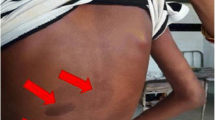Abstract
Background
Alagille syndrome (AS) is regarded as the most common cause of chronic cholestasis in childhood associated with specific phenotypic features in western countries. This study was undertaken to investigate the significance of AS in Chinese children with chronic cholestasis and to describe its clinical and histological features.
Methods
From October 2004 to January 2007, 157 children who presented with conjugated jaundice from less than 3 months of age were admitted to a tertiary hospital in Shanghai. Investigations of the heart, spine, eyes and kidneys were conducted in 13 children who experienced prolonged cholestasis beyond 1 year of age after exclusion of biliary atresia and familial progressive intrahepatic cholestasis type 1 or 2. In patients with interlobular bile duct paucity, AS was diagnosed if 3 or more of the following 5 major features were present: cardiac murmur, posterior embryotoxon, butterfly-like vertebrae, renal abnormalities and characteristic faces. In patients without interlobular bile duct paucity or who did not receive liver biopsy, 4 or more features were required for the diagnosis.
Results
Of the 13 children, 6 were diagnosed with AS at ages ranging from 1 year and 7 months to 3 years and 11 months. Jaundice was noticed in early infancy and then pruritus developed in all the 6 patients, of whom 5 presented with acholic stool and 4 had been misdiagnosed as having presumed biliary atresia by hepatobiliary scintigraphy or laparoscopic cholangiography. Biochemical examinations demonstrated increased concentration of total bile acid and hyperlipidemia. Interlobular bile duct paucity was demonstrated histologically in 5 patients who received liver biopsy. Vertebral abnormalities, heart murmur, characteristic faces and failure to thrive were found in all the 6 patients. Two patients had evidence of renal involvement. Micropenis, empty scrotum, and gall stone were seen in 1 patient.
Conclusion
AS is also an important cause of prolonged cholestasis in Chinese children. It is difficult to differentiate AS from biliary atresia. Liver biopsy and spine X-ray may be helpful in the early detection of AS.
Similar content being viewed by others
References
Alagille D, Odievre M, Gautier M, Dommergues JP. Hepatic ductular hypoplasia associated with characteristic facies, vertebral malformations, retarded physical, mental, and sexual development, and cardiac murmur. J Pediatr 1975;86:63–71.
Alagille D, Estrada A, Hadchouel M, Gautier M, Odièvre M, Dommergues JP. Syndromic paucity of interlobular bile ducts (Alagille syndrome or arteriohepatic dysplasia): review of 80 cases. J Pediatr 1987;110:195–200.
Piccoli DA. Alagille syndrome. In: Suchy FJ, Sokal RJ, Balistreri WF, eds. Liver disease in children, 2nd ed. Philadelphia: Lippincott Williams & Wilkins, 2001: 327–342.
Fan ST, Lo CM, Chan KL, Lo R, Saing H, Wei W, et al. Liver transplantation-perspective from Hong Kong. Hepatogastroenterology 1996;43:893–897.
Balistreri WF, Bezerra JA, Jansen P, Karpen SJ, Shneider BL, Suchy FJ. Intrahepatic cholestasis: summary of an American Association for the Study of Liver Diseases single-topic conference. Hepatology 2005;42:222–235.
Hoffenberg EJ, Narkewicz MR, Sondheimer JM, Smith DJ, Silverman A, Sokol RJ. Outcome of syndromic paucity of interlobular bile ducts (Alagille syndrome) with onset of cholestasis in infancy. J Pediatr 1995;127:220–224.
Kim B, Park SH, Yang HR, Seo JK, Kim WS, Chi JG. Hepatocellular carcinoma occurring in Alagille syndrome. Pathol Res Pract 2005;201:55–60.
Kasahara M, Kiuchi T, Inomata Y, Uryuhara K, Sakamoto S, Ito T, et al. Living-related liver transplantation for Alagille syndrome. Transplantation 2003;75:2147–2150.
Kamath BM, Spinner NB, Emerick KM, Chudley AE, Booth C, Piccoli DA, et al. Vascular anomalies in Alagille syndrome: a significant cause of morbidity and mortality. Circulation 2004;109:1354–1358.
Kamath BM, Loomes KM, Oakey RJ, Emerick KE, Conversano T, Spinner NB, et al. Facial features in Alagille syndrome: specific or cholestasis facies? Am J Med Genet 2002;112:163–170.
Tolia V, Dubois RS, Watts FB, Perrin E. Renal abnormalities in paucity of interlobular bile ducts. J Pediatr Gastroenterol Nutr 1987;6:971–976.
Hashida Y, Yunis EJ. Syndromatic paucity of interlobular bile ducts: hepatic histopathology of the early and endstage liver. Pediatr Pathol 1988;8:1–15.
Lykavieris P, Hadchouel M, Chardot C, Bernard O. Outcome of liver disease in children with Alagille syndrome: a study of 163 patients. Gut 2001;49:431–435.
Warthen DM, Moore EC, Kamath BM, Morrissette JJ, Sanchez P, Piccoli DA, et al. Jagged1 (JAG1) mutations in Alagille syndrome: increasing the mutation detection rate. Hum Mutat 2006;27:436–443.
Author information
Authors and Affiliations
Corresponding author
Rights and permissions
About this article
Cite this article
Wang, JS., Wang, XH., Zhu, QR. et al. Clinical and pathological characteristics of Alagille syndrome in Chinese children. World J Pediatr 4, 283–288 (2008). https://doi.org/10.1007/s12519-008-0051-5
Received:
Accepted:
Published:
Issue Date:
DOI: https://doi.org/10.1007/s12519-008-0051-5




